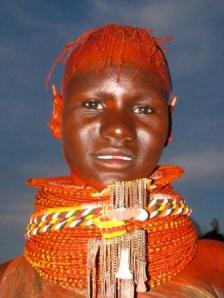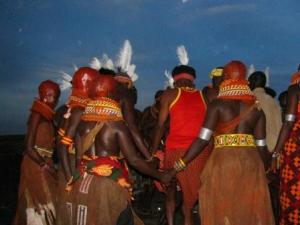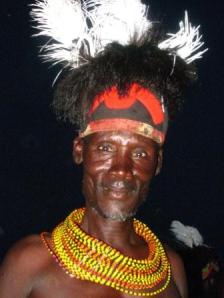Omar insisted on staying up until Kura arrived. It was after midnight when Kura finally knocked on my hut door to let me know that they had arrived safely. Despite the roads and mechanical problems, he was very excited to tell me that they had seen four cheetahs. We agreed that we would delay the training program for a day, so that everyone could relax tomorrow after the long journeys. The training program would start the following day.
The next morning, before it got too hot, we loaded up the vehicles and headed to the Desert Museum, curiously situated over 5 kilometers from town. Our group of Mentors and BOMA staff enjoyed being hosted by Makambo Lotorobo. Makambo was one of BOMA’s vocational scholarship students who received a certificate in Information Technology at a Nairobi technical school. He is now, proudly, the Curator of the Desert Museum. Makambo is an articulate gentle giant of a man, passionate about the challenges that, as he describes it, “the cosmopolitan mix of people in Loiyangalani” – the Samburu, Turkana, Rendille and Elmolo – face.
The greatest concern is the current construction of the Gibe III Dam of the Omo River in Ethiopia that will affect Lake Turkana. If the level of the lake drops, the alkalinity will change, threatening the survival of the fish, crocodiles, hippos and other wildlife that inhabit the lake as well as the income sources for the local people. The international outcry over the Dam has forced the World Bank, the European Investment Bank and the African Development Bank to pull out. The Italian’s, however, are continuing with the contract to build the dam. And the Chinese are more than willing to step in as the new funders. And unfortunately the Kenyan government is more than willing to purchase the energy from Ethiopia, essentially throwing the people around Lake Turkana under the bus in their quest for energy. Friends of Lake Turkana, a local ngo: http://www.friendsoflaketurkana.org/ & International Rivers, an advocacy organization: http://www.internationalrivers.org/africa/ethiopia/field-report-fighting-lake-turkana
The wind died in the afternoon. We wilted. The huts did not provide relief from the heat so the Mentors gathered in informal circles under the palm trees, chatting. At five, we packed up the vehicles and headed to the shores of the lake for wading, drinks and spicy vegetable samosas. Benedict brought the chairs and tables and Makambo arranged for Turkana dancers to join us. The dancing lasted for over an hour, long past the time when the sun had set. Turkana dancing is physically powerful; the bells on their legs ring constantly as they pound the ground with their bare feet. The men and women grip each other’s arms forcing their bodies to each side; then circling, then jumping. At times the men collapse in an exhausted heap on the ground, laughing. All of the men are adorned with ostrich feathers – one of the men has an elaborate headdress of black and white ostrich feathers. The other men have clay skullcaps that are attached to their heads with a single white ostrich feather sticking up out of the clay. Their skin is scarred with lines and raised bumps. The young girls are covered in red ochre, some of them clearly younger than 12 years. I recognize two of the dancers as REAP participants and they break the dancing circle to shake my hand.
We share the rest of the food and drinks with the exhausted dancers. The young women scurry behind the vehicles as they are not allowed to eat in the presence of men. Sitting in the dark, Kura encourages the Mentors to raise their fists as he declares, “BOMA power!” All you can see is the BOMA glow-in-the-dark wristbands as they shine in a moment of solidarity that is moving for us all.



